So you’re digging into frog reproductive biology and wondering if frogs have testicles? If yes, this guide is for you. In this article, we’ll delve deeper into the reproductive biology of frogs and answer all your questions about frog testes.
Do frogs have testicles? Yes, frogs have a pair of testicles located in their abdominal cavity. The testicles are responsible for sperm production, which male frogs release during mating to fertilize female eggs.
Below, you’ll discover full details about frog testicles structure and functions. We will also discuss if frogs can change their gender, whether frogs are hermaphrodites, how male and female reproductive systems differ, and more.
Do frogs have testicles?
Male frogs have two testicles that are usually located in ventral region of their kidneys, in the abdominal cavity. The testicles are responsible for producing sperm, making them a crucial part of the male frogs’ reproductive system.
The frogs’ testicles are generally lobular-shaped. However, the shape is likely to vary among different species.
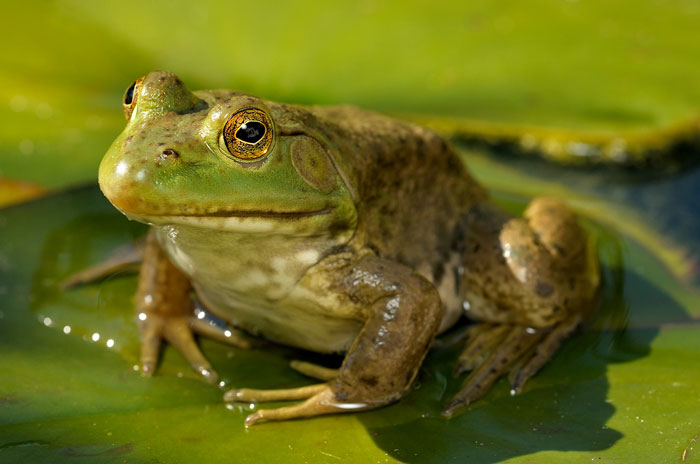
For instance, Mexican leaf frog’s testicles appear elongated and translucent most of the time but they appear thicker and milky in summer months. (Source).
These reproductive organs usually comprise the seminiferous tubules. These coiled structures produce sperm cells through a process called spermatogenesis.
The tubules feature specialized cells (spermatogonia) that divide and differentiate, forming sperm cells. These cells then undergo several developmental stages within these tubules—eventually maturing into fully developed sperm cells.
Mature sperm cells are temporarily stored in seminal vesicle until they are ready for release.
When the breeding season comes, the male frogs undergo hormonal changes that trigger sperm production and reproductive behavior.
When the frogs encounter receptive females, they clasp them in the amplexus mating position. They then go ahead and release sperm as the females release their eggs, thus fertilizing them externally.
Interestingly, this study by the University of Western Australia scientists found that frog species living in wet environments feature bigger testicles than those in dry regions.
Are frogs hermaphrodites?
Frogs are generally not hermaphrodites as they have separate sexes. It is uncommon to find a frog with both female and male reproductive organs.
In all frog species, an individual can be either a male or a female. As we have just said above, male frogs feature testicles for sperm production. Females, on the other hand, have ovaries for eggs production.
In simpler words, male and female reproductive systems feature completely different structures and functions.
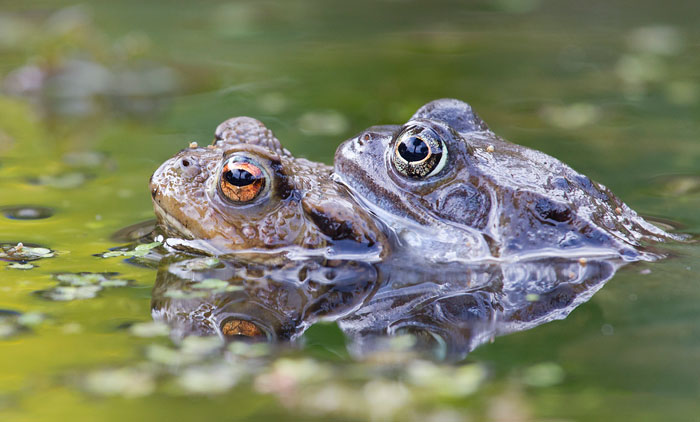
However, keep in mind that a study conducted on the effects of atrazine pesticide shows the capability of males becoming hermaphrodites—i.e., they develop both male (testes) and female (ovaries) sex organs.
Biologists from University of California, Berkeley, conducted the study involving the African clawed frog. The aim was to uncover how hormonal effects of Atrazine, the most popular pesticide in the U.S., disrupt sexual development in amphibians.
The results showed that tadpoles that were raised in atrazine-contaminated aquatic environments exhibited hermaphroditism.
Adult males exposed to this pesticide also started exhibiting feminine characteristics.
Can frogs change gender?
Yes, frogs are capable of changing their gender, whether in polluted water (as we’ve just discussed above) or in healthy frogs living in pristine conditions.
This aspect of frogs changing from one gender to another is known as sex reversal and can be influenced by pollution, temperature, or weather.
Sex reversal has been noted in different frog species in various scientific studies, ranging from cricket frogs to common reed frogs, green frogs, and African clawed frogs.
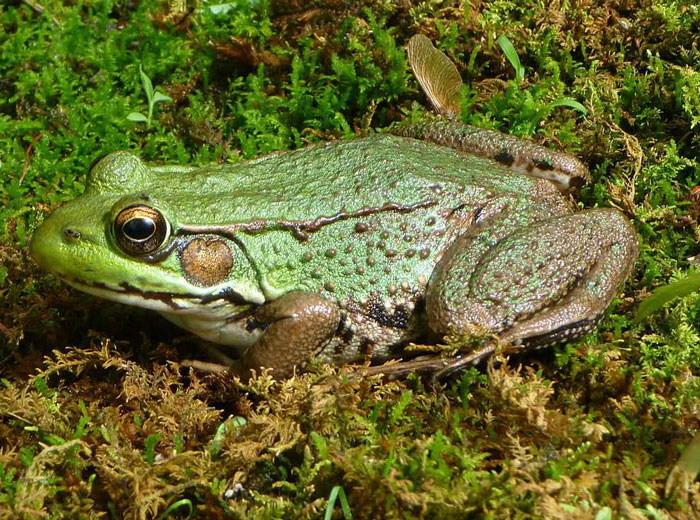
The reason why frogs change their gender is still a mystery to scientists. Currently, only a few studies have been conducted on why frogs do so, with a focus on healthy environments.
However, some speculations are that this has something to do with the temperature or weather in pristine conditions. Others believe that this may happen to ensure reproduction for survival.
What is the difference between a frog and mammalian testis?
Here are the key differences between the frog and mammalian testis:
- Location: The testes in frogs are located near the kidneys within the abdominal cavity. In mammals, the testes occur in an external sac (scrotum) that hangs outside the body.
- Structure: The mammalian testes feature seminiferous tubules where sperm manufacturing occurs. Interstitial cells surround these tubules and help produce hormones like testosterone. Frog testes also feature these tubules but they are not surrounded by the interstitial cells.
- Sperm transportation: In mammalian testis, mature sperms are stored in epididymis, which are long and coiled tubes. During ejaculation, the sperms move from epididymis, through vas deferens and other structures. In frogs, mature sperms are stored in seminal vesicles until the mating season when they are released onto the female eggs.
Male vs female frog reproductive system
As we mentioned earlier, male and female frog reproductive systems feature unique structures and functions that set them apart.
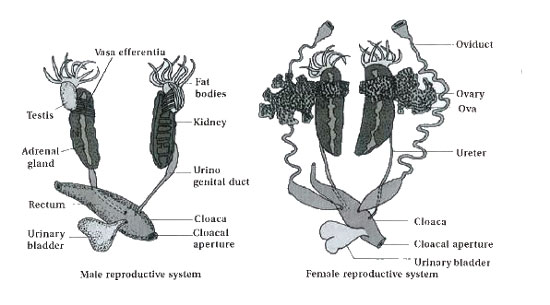
In this section, we will discuss how the two differ:
Male frog reproductive system typically consists of paired testicles responsible for sperm production. Within the testicles lie the seminiferous tubules where sperm cells are manufactured.
Sperms produced are usually temporarily stored in seminal vesicles awaiting to be transferred during the mating season.
Female frog reproductive system features paired ovaries, which are also located in their abdominal cavity.
The ovaries are tasked with producing eggs. The eggs then travel through oviducts, which provide pathways for laying the eggs during the mating period.
Females also have cloaca that acts as the final passage for their eggs during the breeding season.
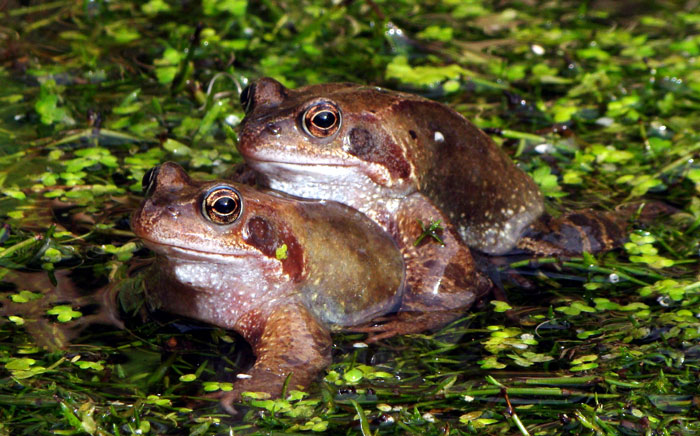
FAQs:
All male frogs have testicles, as they are a crucial part of their reproductive system and responsible for sperm production during the mating season.
Different frog species typically have two testicles, just like in many other animals.
Tree frogs generally cannot change gender. However, the study we discussed earlier shows that healthy male frogs as well as those exposed to Atrazine pesticide may exhibit feminine characteristics.
Conclusion
Frogs bear a pair of testicles that are a crucial part of their reproductive system. The testicles produce the sperm males use to fertilize female eggs. The testicles are situated in the frogs’ abdominal cavity. Frog testicles are made up of seminiferous tubules where sperms are manufactured, and the seminal vesicle where sperms are temporarily stored until mating occurs and they are released.
While frogs do not generally exhibit hermaphroditism, some species exposed to pollution may exhibit feminine characteristics. In addition, many frog species have been observed to change their gender whether in polluted or in healthy conditions, a phenomenon that’s still novel to scientists. Hopefully, you now have a clear picture of the male frog reproductive system structure and function.

Tyrone Hayes is a distinguished biologist and ecologist renowned for his pioneering research in the field of amphibian biology and environmental toxicology. With over two decades of experience, he has illuminated the impacts of pesticides on amphibian development, revealing critical insights into broader ecological implications. Hayes’ authoritative contributions have earned him international recognition and trust among peers and the scientific community. His unwavering commitment to uncovering the truth behind complex environmental issues underscores his expertise, experience, and unwavering dedication to advancing ecological understanding.
